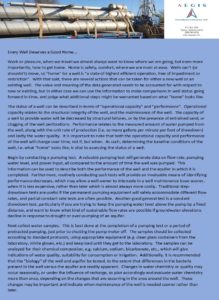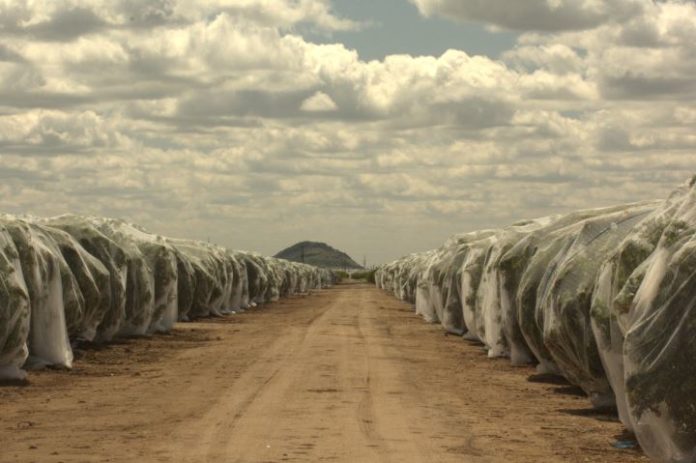 The South Valley Water Association met at the Lower Tule River Irrigation District headquarters on Monday, February 18, 2019. It was a beautiful drive with snow on lower peaks of the Sierra Nevada where I’ve never seen snow before. The meeting started about 9:00am with the real Jim Costa Chairing. I was five minutes late; I don’t usually admit that in print but in this case I will. All I missed with the minutes and they were approved.
The South Valley Water Association met at the Lower Tule River Irrigation District headquarters on Monday, February 18, 2019. It was a beautiful drive with snow on lower peaks of the Sierra Nevada where I’ve never seen snow before. The meeting started about 9:00am with the real Jim Costa Chairing. I was five minutes late; I don’t usually admit that in print but in this case I will. All I missed with the minutes and they were approved.
When I walked in Executive Director Dan Vink was giving a water supply update. This is the time of year where  allocations are starting to firm up. The members of SVWA are Friant Division of the Central Valley Project contractors. Vink was critical of the process. There is a great snow pack and the contract with the US Bureau of Reclamation calls for certain terms. It looks like 100 percent Class One for 800,000 a/f and a 55 percent Class II allocation for 77,700 a/f. There was some warm rain recently but not enough to cause a perceptible impact. It has since become colder.
allocations are starting to firm up. The members of SVWA are Friant Division of the Central Valley Project contractors. Vink was critical of the process. There is a great snow pack and the contract with the US Bureau of Reclamation calls for certain terms. It looks like 100 percent Class One for 800,000 a/f and a 55 percent Class II allocation for 77,700 a/f. There was some warm rain recently but not enough to cause a perceptible impact. It has since become colder.
Unity on the Friant
The financial matters passed and Vink introduced Chris Tantau, Chairman of the Friant Water Authority board. (I wrote Friant Water Users and had to change that.) FWA sent letters to the SVWA members inviting closer ties. Costa invited Tantau to today’s meeting. Tantau spoke about the common problem of subsidence on the Friant Kern Canal. He said there will be a workshop next month and wants everyone to share their input because all of them are a part of the solution. Tantau was direct – he wants to hear from the SVWA members and said he is the one with the agenda power and is willing to use it in cooperation. He was back in Washington DC and there are some funding possibilities all Friant contractors should be a part of. Same with title transfer on the FKC. He invited all the directors to attend the FWA meeting later this month. He said since everyone is involved with the O&M he is willing to set the agenda with an O&M block so they don’t have to sit through the entire meeting. He’s going to send everyone an official invitation and invited questions.
Joe Ferreira asked him about the amount of capacity in the canal Tantau’s board is willing to settle for in the short-term. He said with the exception of Fresno Irrigation District there is a $100 million price tag for all the FWA districts. If it gets much bigger than this some of the districts upstream of the subsidence impacted area “kink as I like to call it” on the FKC might not want to go out of pocket. Lending would be much easier to obtain if the canal wasn’t owned by the feds. While in DC Senator Diane Feinstein said she’d write legislation tomorrow to transfer the title to the canal. It’s no secrete there have been problems between Friant contractors. It’s a big canal with various needs along its various reaches. The formation of an ad hoc committee is gaining traction. FWA members can’t vote at SVWA meetings and vise a versa. An ad hoc comprised of members from both groups could be a better way to insure communication. One thing to consider is paying upfront for designing the biggest fix to the kink whether or not it is feasible financially so the options are open. I think Tantau’s visit went well. Good for him.
Moving on Vink said the state wants the Wildlife, Drought & Flood Protection bond act of 2020 and is soliciting input. He said the state senator whose name I didn’t catch didn’t think there would be funding for the FKC after the Prop Three loss. Vink said had Prop Three passed there would be 750,000,000 reasons to get together and talk on the repair of the FKC. He let Tantau know SVWA is actively looking for funds to apply to the canal. He also said there was a recent meeting on Temperance Flat. Attorney Alex Peltzer reported after looking at the latest draft of the feasibility report and he commented this report needs to be finalized. He said there was concerns that were passed on to the Bureau and Stantec Engineering. He said the project is clearly not being led by Friant contractors. Friant contractors need to be included much more to avoid some of the other problems. Such as; San Joaquin River water supply wasn’t being shared to Friant contractors first and not third-party investors. The way water rights are being perfected in this draft is also problematic. Peltzer said the Bureau told him the WIIN Act was running some of this and the feds will only pay for fish and such; other benefits need to accrue to investors. The old way was the Bureau paid for things and the contractors paid it back. Now it appears the process is lead by investors. That  caused a good deal of discussion on how to spend the money. Eric Limas reported the MOU group is just about finished modeling the benefits. He said the modelers were told not to just churn out a 100-page report – to break it down to understandable material to be presented to the boards. Temp Flat increases storage by 1.5 million a/f but the new water development is much less. The real benefit is the flexibility the additional storage provides. Peltzer said there hasn’t been the offline projects along the FKC because the storage flexibility hasn’t been in place. With SGMA this becomes even more valuable. As Vink said when SGMA kicks in folks will start counting water by the molecule. Peltzer said Reclamation projects aren’t going to be done status quo anymore.
caused a good deal of discussion on how to spend the money. Eric Limas reported the MOU group is just about finished modeling the benefits. He said the modelers were told not to just churn out a 100-page report – to break it down to understandable material to be presented to the boards. Temp Flat increases storage by 1.5 million a/f but the new water development is much less. The real benefit is the flexibility the additional storage provides. Peltzer said there hasn’t been the offline projects along the FKC because the storage flexibility hasn’t been in place. With SGMA this becomes even more valuable. As Vink said when SGMA kicks in folks will start counting water by the molecule. Peltzer said Reclamation projects aren’t going to be done status quo anymore.
Vink said there will be a meeting with Ernest Conant on February 28th. Conant is the new Director of the Mid-Pacific Division of the USBR. DWR Director Karla Nemeth will be visiting the SJV for a SGMA update. Good for her. There’s going to be a tour of the area for the congressional types.
Fish Bio
Next two ladies from Fish Bio spoke to the board about the Reconsultation (ROC LTO I forget what it stands for). Shaara Ainsley and Andrea Fuller VP spoke. Doug Demko usually speaks but Fuller is VP of Fish Bio, from Oakdale and has been working on SJR matters for more than 20-years. The first thing they talked about was floodplains. The flood plain at the Delta was seasonal. During the winter the Sacramento River contributes to the northern portion of the floodplain and during the summer the San Joaquin River contributes to the southern portion of the floodplain. There is a different between a levee  and a dyke. Land behind a dyke is below water level. Now you know. I’ve been misusing those terms for most of my life. Well, up to this morning anyway. Most of the floodplain in the Delta is now developed. The habitat has largely been replaced by riprap along the levees that attract non-native aquatic plants that don’t serve the fish population. This makes it tough on the fish. Many benefits were lost to developing the floodplain; flood management, water quality, recharge, bird habitat, carbon sequestration and peat rich soil were mentioned. Floodplains greatly benefit salmon because there is often 100x the food there. Fuller said in addition to the extra food there is less predation because there are more places to hide and the salmon don’t have to swim as hard due to lack of river currents. At the same age fish who get to hang out in the floodplains are usually twice as big as the fish who don’t. The bigger fish survive better both on their way out of the Delta and once they reach the Pacific Ocean.
and a dyke. Land behind a dyke is below water level. Now you know. I’ve been misusing those terms for most of my life. Well, up to this morning anyway. Most of the floodplain in the Delta is now developed. The habitat has largely been replaced by riprap along the levees that attract non-native aquatic plants that don’t serve the fish population. This makes it tough on the fish. Many benefits were lost to developing the floodplain; flood management, water quality, recharge, bird habitat, carbon sequestration and peat rich soil were mentioned. Floodplains greatly benefit salmon because there is often 100x the food there. Fuller said in addition to the extra food there is less predation because there are more places to hide and the salmon don’t have to swim as hard due to lack of river currents. At the same age fish who get to hang out in the floodplains are usually twice as big as the fish who don’t. The bigger fish survive better both on their way out of the Delta and once they reach the Pacific Ocean.
The floodplain spreads from the river and is shallow. This shallow water warms and grows phytoplankton. The  phytoplankton feeds zooplankton which in turn feeds the young salmon. As the floodplain drains back into the river this “soup” feeds the life in the river. Since the Delta has largely developed in the floodplain the reclaimed land can’t be returned to nature. The Yolo Bypass is an example of the “Reconciliation Floodplain.” The Yolo Bypass protects the Sacramento area and requires far less water to gain positive results. It can be flooded in the summer and provide for the rivers’ food webs. Setback levees can serve both the habitat and agriculture. Rice can be grown on floodplains. The comparable, positive results for fish of more through Delta flow and floodplain water use isn’t exactly quantifiable but the benefit of floodplains is much greater at a fraction of the amount of water. This is a repeatable fact so quantification will be developed eventually. The Fish & Game Commission is separate from California Fish & Wildlife and evidently F&G has the clout to shut down efforts to reduce the predation by non-native predators like striped bass. Fuller said Fish Bio did a study that showed there were enough bass to consume the entire salmon population. Sometimes releasing water through the summer to cool the fish actually strands them from reaching the ocean as it can heat up by the time it gets to the Delta. Record numbers of salmon return to the SJR on the heals of drought. The commercial salmon fishing interests are starting to get it.
phytoplankton feeds zooplankton which in turn feeds the young salmon. As the floodplain drains back into the river this “soup” feeds the life in the river. Since the Delta has largely developed in the floodplain the reclaimed land can’t be returned to nature. The Yolo Bypass is an example of the “Reconciliation Floodplain.” The Yolo Bypass protects the Sacramento area and requires far less water to gain positive results. It can be flooded in the summer and provide for the rivers’ food webs. Setback levees can serve both the habitat and agriculture. Rice can be grown on floodplains. The comparable, positive results for fish of more through Delta flow and floodplain water use isn’t exactly quantifiable but the benefit of floodplains is much greater at a fraction of the amount of water. This is a repeatable fact so quantification will be developed eventually. The Fish & Game Commission is separate from California Fish & Wildlife and evidently F&G has the clout to shut down efforts to reduce the predation by non-native predators like striped bass. Fuller said Fish Bio did a study that showed there were enough bass to consume the entire salmon population. Sometimes releasing water through the summer to cool the fish actually strands them from reaching the ocean as it can heat up by the time it gets to the Delta. Record numbers of salmon return to the SJR on the heals of drought. The commercial salmon fishing interests are starting to get it.
Paradise Cut is a smaller bypass on the SJR southeast of Manteca. It isn’t even a 10th of the Yolo Bypass but increased groups of smaller floodplains could be feasible. On YouTube you can look at a video called Saving the Salmon; Growing Fish Food by River Garden Farms. Vink commented the progress that can come from knowledge will pay off. As usual Fish Bio did a great job educating me.
Delta Flows
Next Vink spoke on the Voluntary Settlement Agreement on both the San Joaquin and Sacramento Rivers in response to through Delta flows. He said the State Board started this a while ago and Friant has been very strident to be sure the upper SJR has already contributed to through Delta flows by way of the salmon restoration agreement. The State Board agreed to this but talk about using more Friant water has slipped back in. It’s not sure how but it’s time to fight. He put a slide up with policy positions that stated the USBR can’t make a unilateral decision to dedicate contracted water for Delta outflows. This would be recirculation flows from the SJR restoration program. This will create another level of uncertainty for Friant contractors. Any programmatic change will require by-in by Friant. Peltzer said anything else will violate the contract between Friant contractors and the USBR.
Vink said just pouring water out under the Golden Gate Bridge has been useless. Delta water going to Exchange Contractors must be a priority, not just using Friant water as a backstop. Vink said the tributaries have long objected to SJR recirculation flows going back to Friant. If I understood correctly the State Board is trying to do away with 215 Water. Don’t quote me on that just yet. Tantau was asked for a response and said he is having FWA staff do a white paper detailing its position for SVWA and others. He said South Valley has come up with some concerns that need addressing. He and Vink said disagreements need to be handled within the two organizations. The rest of the meeting went into closed session.
DISCLAIMER OF RESPONSIBILITY; Waterwrights.net strives to provide his clients with the most complete, up-to-date, and accurate information available. Nevertheless, Waterwrights.net does not serve as a guarantor of the accuracy or completeness of the information provided, and specifically disclaims any and all responsibility for information that is not accurate, up-to-date, or complete. Waterwrights.net’s clients therefore rely on the accuracy, completeness and timeliness of information from Waterwrights.net entirely at their own risk. The opinions expressed in this report are those of the author and do not represent any advertisers or third parties.
ALL RIGHTS RESERVED. Copyright 2019 by Don A. Wright
South Valley Water Association – Dan Vink, General Manager. Alex Peltzer, Attorney. Eric Limas & Jarno Mayes Financial Guru. Member agencies: Lower Tule River ID, Pixley ID, Delano Earlimart ID, Exeter ID, Ivanhoe ID, Tea Pot Dome ID, Shafter Wasco ID, South San Joaquin Municipal UD and Stone Corral ID.
































